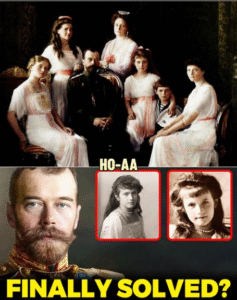The Tragic End of Russia’s Last Imperial Family
The fall of Russia’s last imperial family remains one of the most dramatic and poignant episodes in modern history. The Romanovs, who ruled Russia for more than three centuries, met a tragic end in 1918, marking not only the collapse of a dynasty but also a profound turning point in Russian and world history. Their story is a tale of opulence, misfortune, and political upheaval that continues to captivate historians and the public alike.
The Romanovs: A Dynasty in Decline
The Romanov dynasty came to power in 1613 with the ascension of Michael I, ruling Russia through periods of expansion, reform, and turbulence. By the early 20th century, the Romanovs had become synonymous with imperial splendor, yet the dynasty faced growing social, political, and economic pressures.
Tsar Nicholas II, the last emperor, ascended the throne in 1894. His reign coincided with a period of intense change: industrialization, social unrest, and increasing demands for political reform. Though Nicholas II was personally devoted to his family and deeply religious, he lacked the political acumen necessary to navigate the mounting crises in Russia.
Nicholas II and His Family
Nicholas II was married to Alexandra Feodorovna, the granddaughter of Britain’s Queen Victoria. Their union produced five children: Olga, Tatiana, Maria, Anastasia, and the only son, Alexei, heir to the throne. The family’s private life was marked by devotion and love, but it was also clouded by tragedy.
Alexei, the heir, suffered from hemophilia, a hereditary disease that caused internal bleeding and left him extremely vulnerable. Alexandra’s devotion to her son and reliance on mystics like Rasputin for guidance fueled public suspicion and criticism, further eroding confidence in the monarchy.
The Russian Revolution
The Russian Empire faced escalating crises during World War I, with widespread military defeats, food shortages, and political unrest. By 1917, dissatisfaction with Nicholas II’s leadership reached a tipping point. The February Revolution forced Nicholas II to abdicate, ending over 300 years of Romanov rule.
The former emperor and his family were placed under house arrest, first at the Alexander Palace in Tsarskoye Selo and later moved to Tobolsk in Siberia for their safety. Despite their fall from power, the Romanovs remained a potent symbol of autocracy, and their fate became inextricably tied to the political turbulence engulfing Russia.
The Family in Captivity
In captivity, the Romanovs experienced a mix of isolation, fear, and uncertainty. The family attempted to maintain routines, education, and family life, but their environment was marked by constant surveillance and uncertainty about their future. Guards were wary of the family’s potential influence, while revolutionaries debated what to do with them.
The presence of the Bolsheviks in power intensified the threat. Lenin and his government viewed the Romanovs as a rallying point for counter-revolutionary forces. As the Russian Civil War escalated, the provisional measures for the family’s protection became increasingly tenuous, and their safety could no longer be assured.
The Execution at Yekaterinburg
The tragic climax of the Romanovs’ story occurred on the night of July 16-17, 1918, in Yekaterinburg. The family, along with loyal attendants, was held in the Ipatiev House, a grim setting chosen for their detention. Bolshevik authorities, fearing that anti-Bolshevik forces might attempt to rescue the Romanovs, decided to execute them.
In the early hours of July 17, the family was awoken under false pretenses and led to the basement of the house. There, they were confronted by a firing squad. Nicholas II, Alexandra, their five children, and four loyal attendants were executed. Eyewitness reports describe chaos and horror, as the soldiers initially struggled to kill all the victims due to the family members’ attempts to protect one another and the executioners’ lack of training.
The bodies were hastily transported to a nearby forest and initially buried in a shallow, unmarked grave. Attempts to obscure the crime only heightened the historical and cultural shock of the massacre once the truth became widely known.
Aftermath and Historical Significance
The execution of the Romanovs shocked the world and became a symbol of the violent upheaval that characterized the Russian Revolution. The murder of the imperial family extinguished any realistic hope of monarchical restoration and signaled the definitive rise of Bolshevik power.
Internationally, the Romanovs’ deaths elicited condemnation and sorrow. European monarchies, many of whom were related to the Romanovs, viewed the executions as both a personal and political tragedy. In Russia, the act eliminated a potential figurehead for counter-revolutionary forces, but it also fueled anti-Bolshevik sentiment and became a rallying point for those opposed to the new regime.
Myths, Mysteries, and Anastasia
For decades, rumors persisted that one or more members of the Romanov family, particularly the youngest daughter Anastasia, had survived the massacre. Stories of a “lost princess” captivated the public imagination, inspiring books, films, and endless speculation. The myth of Anastasia’s survival symbolized hope and resilience, even in the face of overwhelming tragedy.
In the 1990s, DNA testing confirmed that the remains of the entire Romanov family had been recovered, putting to rest long-standing mysteries. Scientific advances allowed historians to identify the remains of Nicholas, Alexandra, their children, and loyal attendants, providing closure to one of history’s most compelling mysteries.
Legacy and Canonization
The Romanovs’ story has endured as a potent symbol of imperial Russia, political upheaval, and human tragedy. In 2000, the Russian Orthodox Church canonized Nicholas II and his family as martyrs, honoring their faith and suffering. Museums, memorials, and scholarly works continue to explore their lives and deaths, ensuring that their story remains a critical part of Russian and world history.
The tragic end of the Romanovs also serves as a cautionary tale about the consequences of absolute power, social inequality, and political instability. Their downfall reminds historians and the public alike of the fragility of empires and the human cost of revolution.
Cultural Depictions
The Romanovs’ lives and deaths have inspired countless cultural interpretations, from films and television dramas to novels and operas. Their story resonates not only for its political significance but also for the human elements: family bonds, love, fear, and courage in the face of unimaginable circumstances.
From Hollywood adaptations to Russian literature, the Romanovs have become enduring symbols of both imperial grandeur and tragic vulnerability. Their story continues to educate and captivate new generations, offering lessons about history, governance, and the human experience.
Conclusion
The execution of Russia’s last imperial family marked a definitive end to the Romanov dynasty and a profound moment in world history. Their lives, marked by privilege, devotion, and eventual suffering, reflect the complexities of a society in turmoil. The tragic deaths of Nicholas II, Alexandra, and their children illustrate the human consequences of political upheaval and revolution, while their enduring legacy reminds us of the resilience of memory, culture, and historical narrative.
The Romanovs’ story remains a compelling reminder of the fragility of power, the enduring importance of family, and the ways in which history is shaped by both the actions of rulers and the forces of societal change. Even a century later, the tale of Russia’s last imperial family continues to evoke reflection, mourning, and fascination around the world.


